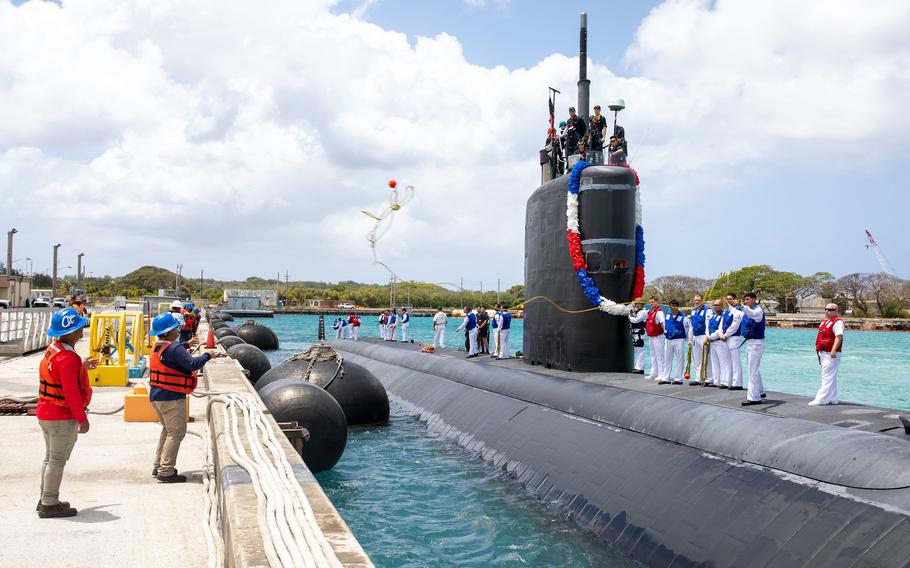The US Navy announced on April 10 that the USS Annapolis, a fast-attack submarine, arrived at Naval Base Guam late last month, bolstering the service’s footprint in the Indo-Pacific.
The Los Angeles-class submarine arrived in Apra Harbor of Guam on March 28 after completing its journey from Naval Base Point Loma in San Diego, according to the statement released by US Navy.
The Navy states that the move is necessary due to the Indo-Pacific security environment, which necessitates deploying the most capable ships forward.
“This posture allows rapid responses for maritime and joint forces, and brings our most capable ships and submarines with the greatest amount of striking power and operational capability to bear in the timeliest manner.”
Annapolis is the fifth Los Angeles-class fast-attack submarine to be currently stationed in Guam, joining the USS Asheville, USS Key West, USS Jefferson City, and USS Springfield. On March 21, the USS Springfield arrived at Guam a week before the USS Annapolis.

“I would like to personally extend a warm Hafa Adai to the Sailors and families of our fifth homeported submarine on Guam, USS Annapolis,” Rear Adm. Benjamin Nicholson, commander of Joint Region Marianas, said in the release. Hafa adai is a greeting used by the Chamorro people of the Mariana Islands.
“Guam and the Mariana Islands are incredibly important to the overall defense of the region, and this additional capability further underscores our commitment to a free and open Indo-Pacific,” he added.
The Los Angeles-class fast-attack submarines are a crucial part of the USA’s submarine force. While some of the early Los Angeles-class submarines have been decommissioned, they remain among the world’s quietest and most powerful submarines presently.
This could be one of the reasons why the US Navy has opted to relocate some of its Los Angeles-class submarines to Guam. The Los Angeles Class was preceded by the Sturgeon Class and succeeded by the Seawolf Class.
The Los Angeles Class was planned and built to be quieter than its predecessors while also carrying more modern sensor and weaponry systems. These cutting-edge vessels were also built to operate beneath the polar icecap. Their diving planes are mounted at the bows of the ships rather than on the sails, and their sails are stronger to penetrate thick ice.
The China Factor
Guam, a strategically important island in Micronesia’s western Pacific Ocean, is playing an increasingly important role in the contentious, difficult, near-peer rivalry environment. It is a crucial component of the US military presence in the Indo-Pacific. In its 2019 Indo-Pacific Strategy Report, the Pentagon stated that it would be “modernizing its force posture” on the island.
The island serves as a tactical axis for all US forces in the region, providing crucial theatre operations and logistical support. Furthermore, it has some of the most important munitions and fuel storage capabilities in the Indo-Pacific, as well as crucial information, surveillance, and reconnaissance (ISR) options and defenses for the island.
Early this year, the USS Nevada, a nuclear-powered submarine of the Ohio class that carries 20 Trident ballistic missiles and dozens of nuclear warheads, had docked at a Navy base in US Pacific Island territory, as previously reported by EurAsian Times.
Despite American frigates and destroyers routinely stationed at US naval ports or friendly countries, this one strikes out because it was a nuclear submarine. It was the first time a ballistic missile submarine, known as a “boomer,” had visited Guam since 2016, and only the second time since the 1980s.
The United States likes to keep the information related to its nuclear submarines a secret. However, making a port call signals an American statement of dominance and strength in the Indo-Pacific region.
“It sends a message — intended or not: we can park 100-odd nuclear warheads on your doorstep and you won’t even know it or be able to do much about it. And the reverse isn’t true and won’t be for a good while,” Thomas Shugart, a former US Navy submarine captain and now an analyst at the Center for a New American Security told CNN.
Additionally, the Andersen Air Force Base, which takes up the majority of the island’s north part, is the only US base in the Western Pacific capable of storing heavy bombers for extended periods. During any potential conflict with China, Guam would be a critical location to monitor Beijing’s movements. Submarines departing from Guam’s Navy base can dive quickly into the deep sea to evade detection.
In recent years, the US has boosted its deployments with its allies around Guam island. The China factor is often regarded as the major driving force behind these developments.
Guam is also within the attack range of China’s DF-26 intermediate-range ballistic missile, which can kill targets up to 3,400 miles away. It’s no surprise that China has labeled this missile “the Guam Killer.”
China recognizes that the US base on Guam is the most serious hindrance to its goal of reunifying Taiwan. As a result, China’s military favors a deterrence posture over an aggressive nuclear war strategy, because it only has a few hundred nuclear weapons compared to the United States’ thousands.
For restricting US movement, the DF-26 is the most crucial missile in its arsenal.
- Contact the author at ashishmichel@gmail.com
- Follow EurAsian Times on Google News